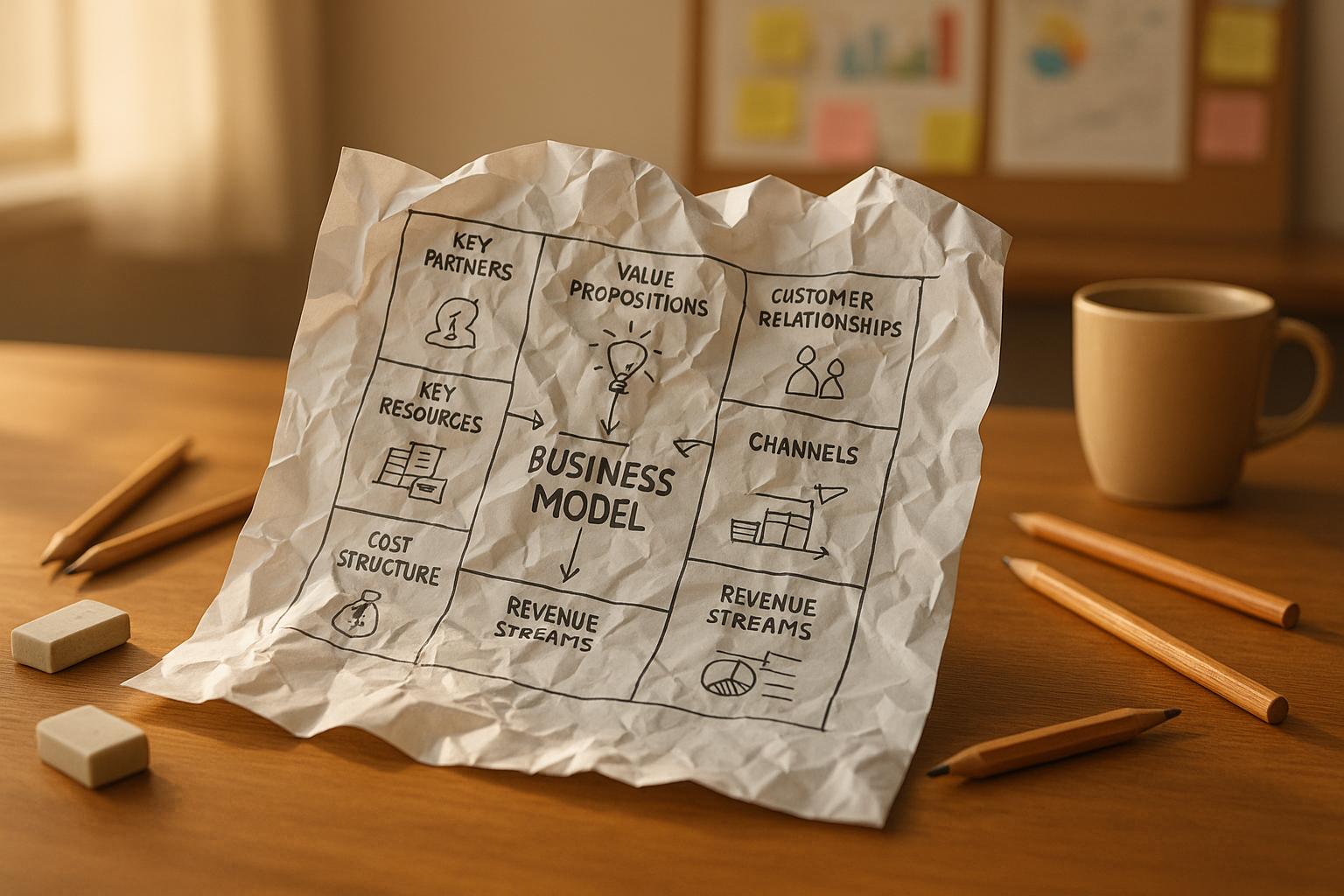
Your first business model will likely fail. Why? Most entrepreneurs focus on their product, not the market need. Here’s the reality:
- 42% of startups fail because there’s no market need.
- 34% fail due to poor product-market fit.
- 38% run out of cash, often from unrealistic assumptions.
Common mistakes include targeting the wrong customers, overestimating market size, and ignoring competitors. Success comes from testing, iterating, and addressing these flaws early. Use tools like Lean Canvas, SWOT analysis, and AI-driven insights to refine your model. Remember: A great product isn’t enough without a scalable, profitable business model.
Key takeaway: Early failures are learning opportunities. Test assumptions, gather customer feedback, and improve continuously. Even companies like Netflix and Airbnb started with flawed models but evolved by learning from their mistakes.
The Graveyard of Untested Ideas - Mastering Validation and Business Models
Why Initial Business Models Fail
Starting a business is tough, and the numbers don’t lie: 90% of startups fail, with 34% of these failures tied to poor product-market fit. To avoid becoming part of this statistic, it’s important to understand where things commonly go wrong. Let’s break down three major reasons why early business models often fail: targeting the wrong customers, overestimating market size, and ignoring the competition.
Wrong Customer Focus
One of the most common mistakes entrepreneurs make is building products without confirming there’s real customer demand. It’s easy to get attached to a vision, but a great idea doesn’t always mean people will pay for it.
Many founders skip the uncomfortable but necessary step of validating their target market. This includes having honest conversations with potential customers, asking tough questions about pricing, and testing whether the product solves a pressing problem. Without this validation, businesses often end up chasing multiple customer segments, diluting their value proposition and failing to connect with any group effectively.
It’s not just about finding people who might be interested - it’s about identifying those who are ready and willing to pay for your solution.
Wrong Market Size Assumptions
Another big pitfall is overestimating market demand. Entrepreneurs often confuse a large theoretical market with a reachable, paying customer base. Just because millions of people could use your product doesn’t mean they will - or that you can afford to reach them.
This mistake can lead to inflated revenue projections and shaky business models. In fact, 38% of startups fail because they run out of money, and unrealistic market size assumptions are often to blame. Early adopters may show enthusiasm, but that doesn’t guarantee your product will appeal to a broader audience. The needs, budgets, and behaviors of mainstream customers are often very different.
Geographic and demographic assumptions also play a role. A solution that works well in one region or for a specific group doesn’t always translate to other markets. Founders often assume their product has universal appeal without taking the time to validate these assumptions.
Poor Competitor Research
Failing to understand the competition is another critical error. 22% of failed startups didn’t implement effective marketing strategies, often due to a lack of insight into their competitive landscape.
"The strategic advantage behind compiling a competitive analysis is that it helps you get a better picture of the competition so you can try to emulate their success but also recognize and avoid their failure." - Christopher Tompkins, Former Forbes Councils Member
Some entrepreneurs ignore competitors altogether, believing their product is so unique that competition doesn’t matter. Others underestimate how quickly competitors can adapt. This oversight leads to unrealistic pricing, weak marketing messages, and features that don’t stand out.
Established competitors can offer valuable lessons about customer behavior, pricing, and operational strategies. Ignoring this knowledge forces new businesses to repeat the same costly mistakes.
"By having data from research, you can always identify digital gaps in the market to stay ahead of the competitive curve." - Cash Colligan, Building Brands Marketing
Competitor research isn’t just about survival - it’s also crucial for funding and partnerships. Investors and collaborators want to see a clear understanding of the competitive landscape and a solid plan for differentiation. Without it, articulating a strong competitive advantage becomes nearly impossible.
| Primary Failure Reason | Percentage of Failures | Key Impact |
|---|---|---|
| Poor Product-Market Fit | 34% | Wrong customer focus, unvalidated ideas |
| Incorrect Marketing Strategies | 22% | Weak competitive positioning, poor messaging |
These issues often overlap. Misunderstanding your customers can lead to unrealistic market projections, and without solid competitor analysis, it’s hard to know if your assumptions hold up in the real world.
How to Find Problems in Your Business Model
A thorough and systematic approach, backed by real data, can help uncover flaws in your business model before they turn into major setbacks.
Use Analysis Frameworks
Structured frameworks offer a clear way to examine every aspect of your business model. Two effective tools are the Lean Canvas and SWOT analysis.
The Lean Canvas breaks your business into nine critical components: problem, solution, key metrics, unique value proposition, unfair advantage, channels, customer segments, cost structure, and revenue streams. Struggling to define areas like your unfair advantage or key metrics often points to gaps in your model that need attention.
On the other hand, SWOT analysis - which focuses on strengths, weaknesses, opportunities, and threats - provides a broader view. It's especially helpful for identifying external factors that could impact your business. Entrepreneurs sometimes get caught up in their strengths while ignoring weaknesses or external risks that could derail their plans.
Signs like uncontrolled burn rates or unclear paths to profitability are red flags. As Mark Cuban famously said:
"Sales cures all ills. But if you're not keeping track of the details, you'll never get to sales."
Ask yourself tough questions: Is your revenue growing? How much cash do you have on hand? How long can you sustain your current burn rate? If you can't answer these clearly, your business model may have fundamental issues that require immediate attention.
Get Direct Customer Feedback
Direct feedback from your customers is essential for validating your assumptions. Instead of relying on polite affirmations, aim for actionable insights.
Customer interviews are a great way to dive deeper into user motivations, pain points, and their willingness to pay. Go beyond surface-level approval and ask about their current solutions, budget limitations, and how they make purchasing decisions.
Surveys provide a scalable way to gather feedback. For example, Airbnb uses Net Promoter Score (NPS) surveys to measure customer satisfaction after bookings, while Amazon monitors service quality through Customer Satisfaction Score (CSAT) surveys. In-app feedback tools - like those used by Slack - allow users to report issues or suggest improvements in real time. Additionally, social media listening can uncover unfiltered customer opinions. Starbucks, for instance, uses social media feedback to decide whether to promote a new drink or make adjustments based on criticism.
Establish a feedback loop: collect data, analyze it, implement changes, and communicate those updates to your customers. Combining direct feedback with automated analysis ensures a more complete understanding of your market.
Use AI Tools for Market Analysis
AI tools can process massive amounts of data in no time, helping you identify patterns and validate your assumptions. These platforms make it easier to uncover hidden opportunities and refine your strategy.
For instance, IdeaFloat's Real Customer Insights scans thousands of online posts to provide data on what customers are saying about your product or service. Similarly, its Competitor Analysis Generator breaks down key industry players - their websites, offerings, strengths, and weaknesses - so you can better understand your position in the market. AI-powered market size assessment tools can also estimate your product's sales potential quickly, saving you weeks of manual research.
These insights allow you to pivot early, before small problems snowball into major failures. Keep in mind that 29% of startups fail because they run out of cash. Many of these failures stem from flaws in the business model. Taking the time to evaluate your model systematically can prevent you from building something that customers don't actually need or want.
sbb-itb-08dd11e
Test and Improve Your Business Model
After identifying potential issues, the next step is to put your business model through a cycle of testing and refinement. This process is all about forming clear hypotheses, testing them with actual customers, and tweaking your approach based on what you learn. It’s a systematic way to separate what works from what doesn’t.
The Testing Process
Testing your business model effectively involves a structured approach: hypothesize, experiment, analyze, and iterate. Start by documenting your assumptions, test them with real customers, review the results, and use those insights to make improvements.
Many companies have shown how iterative testing can lead to higher revenue and lower operational costs. This disciplined approach lays the groundwork for incorporating AI tools, which can significantly speed up the validation process. However, one common mistake is skipping a thorough examination of assumptions, which can lead to flawed conclusions.
How AI Tools Speed Up Testing
Traditionally, validating a business model could take weeks or even months. AI tools, however, can shrink this timeline dramatically. Instead of relying on time-consuming surveys or interviews, AI processes large datasets in minutes, delivering actionable insights almost instantly.
Take IdeaFloat's Validate Score, for example. This tool analyzes real customer conversations and market sentiment to assess business ideas. What might take weeks with manual research can often be completed in just hours. Similarly, Centerline Business Services reduced processing times by 35% using AI-powered tools.
AI doesn’t just save time - it also minimizes human error and bias. These tools can run multiple tests simultaneously, evaluate competitor strategies, and uncover market opportunities that might otherwise go unnoticed.
AI vs. Manual Validation Methods
Compared to manual methods, AI-powered tools stand out for their speed, accuracy, and cost-efficiency. While manual validation relies heavily on staff time and capacity, AI tools can deliver results with up to 95% accuracy, scale effortlessly, and cut costs by 30–40%.
Amanda Carty, General Manager of Compliance at Diligent, highlights how AI-powered due diligence reports make risk management more efficient and scalable. However, the best results often come from combining AI’s capabilities with human judgment. AI can quickly identify patterns and opportunities, but it’s human insight that turns those findings into actionable strategies.
For example, Company C uses AI-driven market analysis alongside strategic partnerships and digital platforms to expand internationally. This balanced approach has helped them increase market reach by 50% and diversify revenue streams. It’s a clear demonstration of how AI tools, when paired with human expertise, can drive meaningful growth.
How to Build Better Business Models
Creating a strong business model requires practices that can evolve, clear metrics to measure success, and a team that’s on the same page. This approach works hand-in-hand with prior testing efforts, creating a cycle where validation and improvement go hand in hand.
Stay Open to Change
One key trait of successful entrepreneurs is their ability to pivot when the data challenges their initial ideas. Instead of clinging to assumptions, they embrace insights that reshape their vision. AI plays a big role here, speeding up analysis of massive datasets, boosting productivity, and uncovering new opportunities. Every piece of feedback, no matter how small, can be a stepping stone toward improving your business model.
Set Clear Testing Goals
Adaptability is important, but it needs direction. That’s where clear testing goals come in. Without specific, measurable benchmarks, progress can lose momentum. For instance, research from Harvard Business Review shows that most strategies only achieve 63% of their potential financial performance. Similarly, a 2001 study by Kaplan and Norton revealed that only 7% of employees fully understand their company’s strategic priorities.
To avoid these pitfalls, use the SMART criteria - Specific, Measurable, Achievable, Relevant, and Time-bound. Instead of a vague goal like "we want more customers", aim for something concrete: "acquire 100 paying customers within 60 days while keeping the customer acquisition cost under $50." Breaking larger objectives into smaller, actionable steps and tracking progress ensures that each test produces meaningful data. Pairing performance goals with learning objectives - for example, figuring out if customers prefer monthly or annual billing - can also provide valuable insights.
Share Plans with Your Team
Clear communication and documentation are essential as your business model evolves. When your team understands both the strategy and the reasoning behind it, they’re better equipped to contribute effectively. Clear goals and expectations reduce confusion and keep everyone aligned.
Tools like IdeaFloat’s Business Plan Generator can help you create detailed, professional plans that are easy to share with your team, advisors, or investors. Features like Share Links allow you to control access to specific information, while the Personalized Launch Checklists provide a step-by-step guide to ensure everyone knows their role in executing and testing your business model.
Regular team discussions also help catch potential issues early. Team members who interact directly with customers or manage operations often have valuable insights that can highlight weaknesses in your strategy. Encouraging open communication and valuing these contributions can strengthen your approach. Involving your team in setting goals not only improves clarity and accountability but also builds greater commitment. When everyone is invested in learning from early mistakes, you create a stronger foundation for long-term success. Combining internal alignment with customer feedback ensures your business model continues to improve over time.
Conclusion: Turn Early Mistakes into Success
Your first business model is just the starting point. While 68% of new businesses make it past the two-year mark, less than half survive beyond five years. Early missteps are not the end - they’re opportunities to refine and improve, as we’ll explore further.
Take Netflix, for instance. The company began in 1997 as a DVD rental service, introduced subscriptions in 1999, and pivoted to streaming by 2007. Each shift was a response to lessons learned along the way, transforming initial challenges into long-term strengths.
The key to success lies in learning quickly and adapting effectively. As AlDhabi AlMheiri, Founder of Rainbow Chimney, wisely states:
"If you understand the concept behind failure and turn it into an opportunity to improve or grow, you can turn over challenges with a very positive thinking."
Start by identifying what went wrong. Were customer needs misunderstood? Was the market size overestimated? Did competitors outmaneuver you? Digging into these root causes is essential. Feedback and market data are your allies, helping pinpoint the adjustments needed. Document these insights and share them with your team to foster a culture where mistakes are seen as learning opportunities.
Modern tools make this process faster and more effective. Platforms like IdeaFloat’s Business Plan Generator allow you to test different strategies quickly. Features like Real Customer Insights and Competitor Analysis provide actionable feedback, while the Validation Score helps track your progress objectively.
These tools, combined with real-world examples, show how resilience leads to success. Airbnb started with air mattresses in a living room and faced countless rejections before evolving into a global hospitality leader. Similarly, Instagram began as Burbn, a location check-in app, until its founders realized users were most drawn to its photo-sharing feature.
Your initial business model doesn’t need to be flawless - it’s a learning tool. By embracing structured validation, leveraging AI-driven insights, and staying open to change, you can turn early challenges into a stronger, market-ready strategy.
FAQs
How can I make sure my business model meets real market needs?
To make sure your business model truly addresses market demands, begin by clearly outlining your goals and assumptions about your target audience and the value you aim to provide. Dive into detailed market research to uncover customer challenges, gauge demand, and spot industry trends. Then, take it a step further by connecting directly with potential customers - think interviews, surveys, or feedback sessions - to validate your findings.
Take what you learn and use it to fine-tune your business model. Keep the momentum going by testing your ideas with actual data and staying flexible enough to adjust as the market evolves. This ongoing, hands-on approach minimizes risks and keeps your business aligned with customer needs.
How can I use AI tools to test and improve my business model effectively?
AI tools are a game-changer for refining your business model. By analyzing customer data and spotting market trends, they provide insights that can elevate your strategy. With predictive analytics, you can understand customer behavior and preferences on a deeper level, helping you make smarter adjustments to your approach.
AI can also simulate different scenarios to test how well your model performs, pinpointing areas that need improvement. On top of that, it can identify hidden patterns in your data, giving you the edge to make more informed decisions. By continuously tweaking and validating your model with AI, you can build a business strategy that’s better aligned with market demands and flexible enough to keep up with changing customer expectations.
How can I use customer feedback to improve my business model?
To refine your business model with customer feedback, begin by establishing a clear and organized feedback loop. Gather input from multiple sources, such as surveys, focus groups, social media conversations, and customer support interactions. Once collected, sort the feedback by sentiment and priority to spot recurring themes and areas that need attention.
Leverage tools like AI-powered analytics to quickly identify trends and gain deeper insights. Prioritize actionable feedback - what your customers genuinely want or need - and experiment with small changes to your business model based on their suggestions. This step-by-step approach keeps you in tune with market expectations and helps you shape a stronger, more adaptable business strategy.
Related posts
Get the newest tips and tricks of starting your business!


